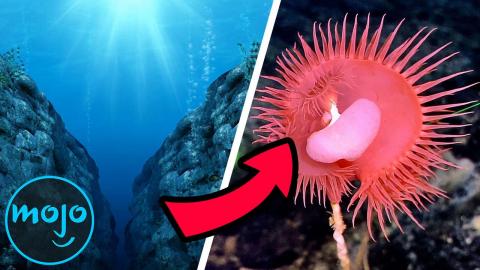Top 10 Places That Have Barely Been Explored

#10: Yucatán Cenotes
Mexico A cenote is a natural sinkhole or pit that reaches groundwater beneath it. They’re especially common on the Yucatán peninsula in Mexico. Most resemble circular cave ponds, but many are more extensive, being connected to larger cave systems. There are an estimated 6,000 cenotes in the Yucatán peninsula, but less than half have been explored fully, as collapsing rocks are common due to the way they form. Many require scuba gear to navigate in their entirety. Unfortunately, this has led to frequent deaths while exploring them, so fully documenting them is difficult and extremely hazardous!
#9: The Rub’ al Khali
Top 30 Creepiest Abandoned Places Around the World
Arabian Peninsula The Rub’ al Khali, or the Empty Quarter, is one of the world’s biggest sand deserts and is a part of the larger Arabian Desert. Despite its name, it actually takes up around a third of the desert’s total area and is incredibly inhospitable, with extreme temperatures that reach as high as 124 degrees Fahrenheit. While it is partially inhabited, large sections of the desert remain unexplored due to how difficult the shifting terrain and environment are to explore. Although several recent crossings have been documented, it’s unlikely that the Rub’ al Khali will be exhaustively explored any time soon.
#8: Northern Patagonia
Top 10 Reasons to Visit Northern California in 2021
Chile Patagonia is a sparsely populated region of South America that includes territory in Chile and Argentina. Its northern portion in Chile is especially wild and largely untouched by human activity. With a diverse terrain that includes rainforests, lava fields, and glaciers, Northern Patagonia is all over the place geographically-speaking, which can make exploring it a challenge. The Northern Patagonian Ice Field is among the largest masses of ice outside of the poles. Though the area is increasingly attracting adventure-minded travelers looking to escape, it’s still far off the beaten path.
#7: Kamchatka Peninsula
Russia Siberia, in general, is considered pretty inhospitable by most standards and, as such, is not heavily populated. While the climate in the Republic of Sakha is particularly extreme, we’re going with the even more remote Kamchatka Peninsula. The region is comparable in length to California, but the golden state’s envious weather is notably missing. The temperatures are frigid. Kamchatka is also home to hundreds of volcanoes, many of which are currently active. As a result, seismic activity, such as earthquakes and tsunamis, are relatively common. Following World War II, Kamchatka was used as a military zone by the Soviets, and as such remained off-limits to civilians and tourists until the 90s.
#6: The Namib Desert
Another Top 10 Most Beautiful Places in The World
Southern Africa Stretching over 1,000 square miles along Africa’s southwestern coast, the Namib is among the least populated areas in the world. Thought to be the oldest surviving desert on Earth, the Namib is also one of the world’s driest regions, which has made humans understandably reluctant to spend much time there. Be that as it may, its oceans of sands boast some of the largest dunes in the world, with some nearly reaching 1,000 feet high! Despite how arid it is, the coast gets a lot of fog, which has caused a large number of shipwrecks, hence one section being nicknamed the Skeleton Coast.
#5: Gangkhar Puensum
Bhutan Located in Bhutan and bordering Tibet, this mountain is the tallest unclimbed mountain on Earth. Although neighboring peaks on the Tibetan side have been scaled, Gangkhar Puensum has yet to be officially climbed. While a Japanese expedition did reach subsidiary peak Liankang Kangri, four attempts to reach the actual summit of Gangkhar Puensum have failed. Since then, the Bhutanese government has outlawed mountaineering due to local spiritual beliefs. Because of this prohibition, rescue services are not readily available, which means that climbing Gangkhar Puensum is ill-advised.
#4: Lake Vostok
Antarctica Antarctica still holds many secrets. The frosty continent has nearly 400 subglacial lakes. The largest of these is Lake Vostok, named for the Russian research station that sits above it. The lake water is estimated to have been isolated from the rest of the world for some 25 million years. This makes it of particular interest for researchers, as its conditions could be similar to the ice-covered bodies of water believed to exist on some moons. As of this writing, very few samples have been taken and only time will tell what kinds of life lies beneath.
#3: Vale do Javari
Brazil The Vale do Javari, or Javari Valley in English, is an area of Brazil roughly the size of Austria, or, if you’re American, think slightly bigger than Maine. Unlike most of our entries, the Vale do Javari is populated. However, most of the residents are part of tribes who haven't had official contact with the outside world. We have scant footage, or even information on these tribes, who’ve been left alone so as not to disturb them. This means that much of the region remains unknown, at least to outsiders
#2: Devon Island
Canada Located west of Greenland and part of Canada’s Queen Elizabeth Islands, Devon Island is the world’s largest uninhabited island. Although briefly inhabited during the mid-20th century, Devon Island has no permanent residents today. Given its polar desert ecosystem, it gets little precipitation and so it supports very little animal or plant life, with temperatures getting as low as negative 58 degrees Fahrenheit. Devon Island’s primary visitors are scientists, as there are a few research stations on the island. Its resemblance to the surface of Mars has made it of particular interest to space agencies. Before we get to our top pick, here are a few honorable mentions: Mount Namuli, Mozambique Many Areas Can Only Be Accessed Through Rock Climbing Mount Roraima, South America Steep Slopes & Three National Borders Make the Logistics Complicated Son Doong Cave, Vietnam The World’s Largest Cave New Hebrides Trench, Pacific Ocean First Explored in 2013
#1: The Mariana Trench
The Real Reason Why We Don't Explore The Mariana Trench | Unveiled
Pacific Ocean Located in the Pacific Ocean near Guam and named for the nearby Marianas Islands, this is the world’s deepest ocean trench. Its greatest confirmed depth is around 6.8 miles, although unconfirmed reports suggest it may be even deeper. Its atmospheric pressure is over 1000 times that of the surface of the sea. This has made it incredibly difficult to explore, and only seven successful descents have been made into the Trench: 4 of them manned, 3 unmanned. Every descent reveals something new about the mysterious trench and the strange flora and fauna that call it home.





